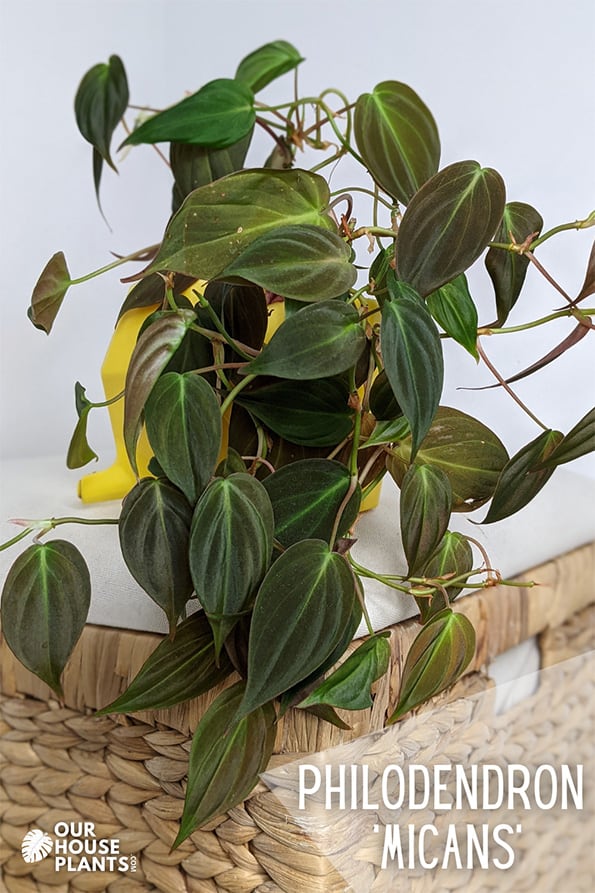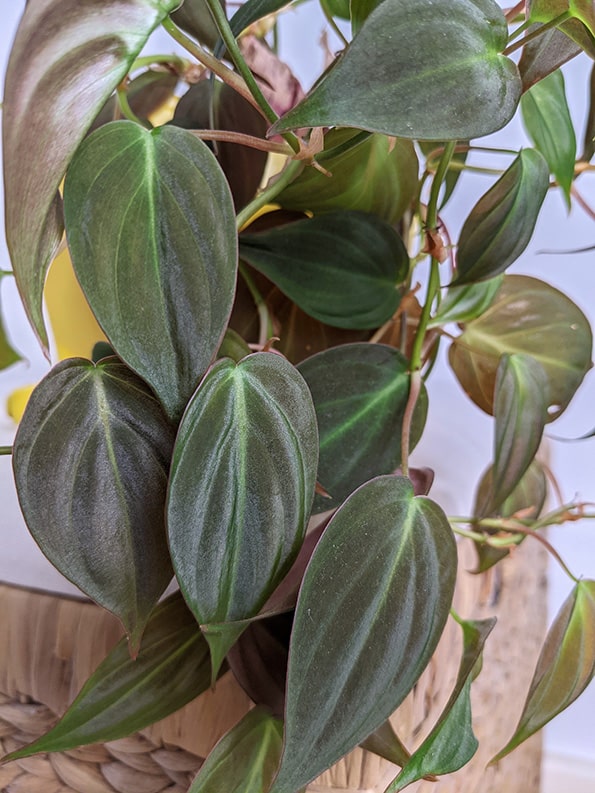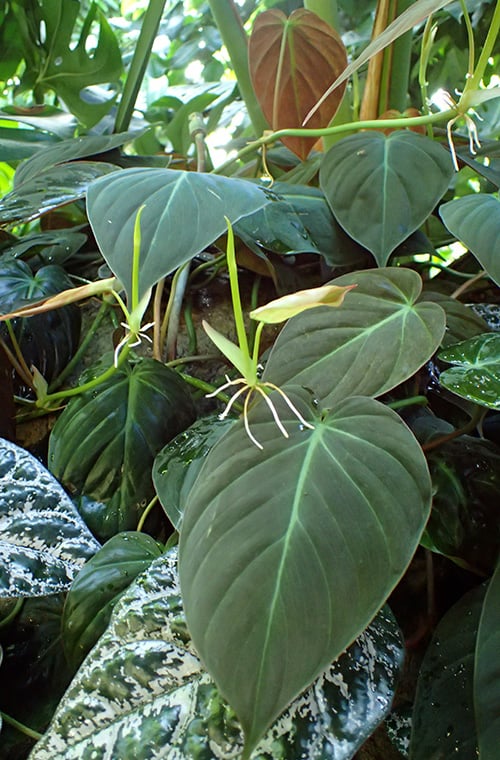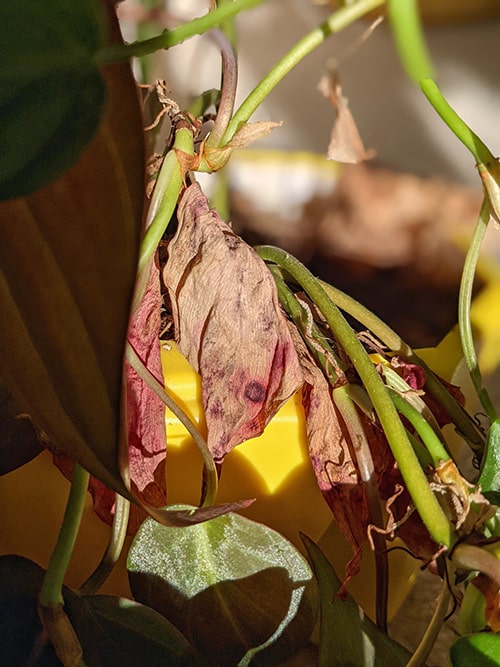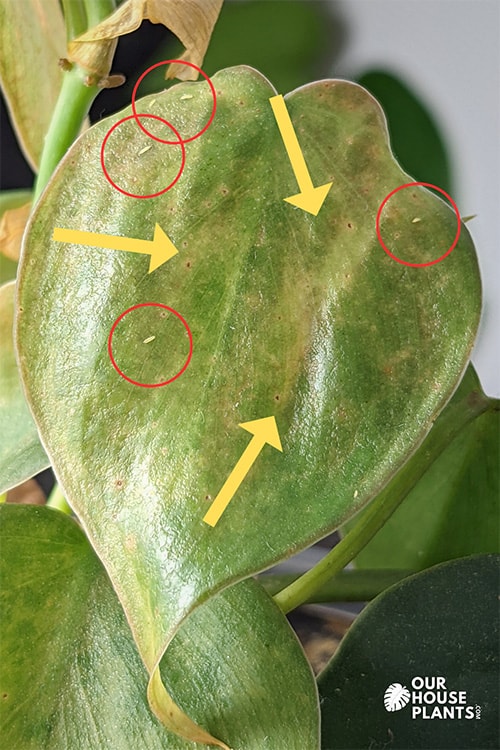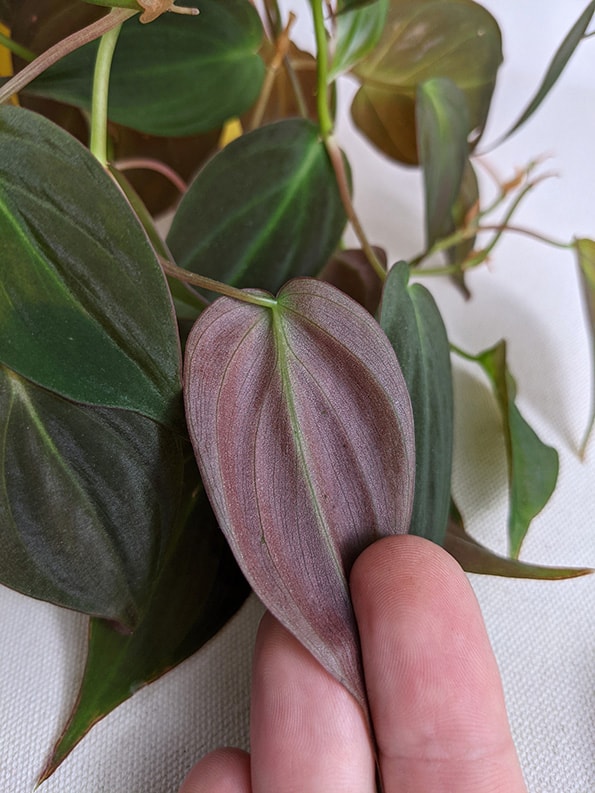With velvety, heart shaped leaves in rich shades of green and bronze, the Philodendron Micans houseplant brings elegance and warmth to your indoor space.
Although many Philodendrons can grow well indoors, the Micans is an easier and more forgiving houseplant in many ways and can be grown in various locations around your home.
Philodendron hederaceum 'Micans' or the Velvet Leaf philodendron is a vining plant with attractive foliage. The leaves are rich in texture, making them both visually and tactilely appealing.
Philodendron Micans is a captivating and highly sought-after houseplant celebrated for its striking foliage and relatively low-maintenance care requirements.
Did You Know?
If you like the Micans, there are several other Philodendron hederaceum plants grown as houseplants you may want to check out. These include the all green Heart leaf Philodendron and the variegated Philodendron Brasil.
Native to the tropical rainforests of Central and South America, this plant belongs to the Araceae family.
What makes it truly stand out are its lush, velvety leaves, which are typically deep green with a bronze or coppery sheen, giving them a distinctive, almost reflective quality.
It has heart-shaped leaves that can be allowed to trail and cascade downwards, or you can allow it to climb up a moss pole.
I'll get onto the Philodendron Micans care details in more detail later on, but in brief. The plant will thrive in bright, indirect light, although it can tolerate some lower light conditions too.
It prefers to be kept fairly moist but not waterlogged, watering frequency will vary throughout the year and depend on your growing conditions.
Plant enthusiasts and everyday owners often fall in love with its captivating appearance and relatively straightforward care. It's an ideal choice for both beginners and experienced indoor gardeners and should flourish in a range of indoor environments.
In the early days, the Philodendron Micans was a rare plant. It was hard to get hold of so was fairly expensive.
Demand and supply have balanced out and although it's still a popular houseplant and sought after, it's now widely cultivated and inexpensive. Its readily available through nurseries, online plant shops, and in garden centers.
Micans is the most popular common name, but Velvet Leaf Philodendron is also used sometimes. Finally, Philodendron hederaceum is the correct scientific species name, but it's commonly sold under the name of Philodendron scandens Micans too.
If you want it to trail downwards, you can grow your Micans in a planter or hanging basket. You can also grow it upwards by using a totem pole filled with coco coir or use a shop brought moss pole. The aerial roots can then be encouraged to anchor into this material as it climbs.

Hi, I'm Tom!
If you're like me and enjoy the challenge of growing houseplants and getting them to thrive, then Ourhouseplants can help. This website shares my knowledge and years of growing plants and provides (hopefully) helpful advice on properly caring for your indoor plant friends.
Your Philodendron Micans will thrive in moderate to bright indirect light. Placing it a few feet away from an east- or west-facing window will provide the ideal amount of light.
Like many Philodendrons, it can survive in lower light conditions, but with the Micans, trying to grow it in low light areas means the plant may not exhibit the a good level of of vibrant growth or the velvety leaf coloration.
Finding the right balance is key. Too much direct sunlight can lead to leaf burn, while too little light can cause the plant to become leggy and diminish the intensity of its leaf coloration. As a general guideline, keep an eye on it's growth over a few months and adjust its position in your home if needed.
Winter Watering Needs.
Reduce the frequency of watering in the winter months. In the dormant period (late fall and winter), the plant's growth slows down. During this time allow at least the top 2 inches (5 cm) of soil to dry out before watering again.
This plant prefers to be kept consistently moist but not waterlogged.
In average growing conditions, it can dry out fully for up to a week. The leaves will probably curl up during this period, and if you leave it much longer then they will start to crisp up. Not ideal, but at least you have a little grace period before it gets to this stage.
The better approach is to try and water when the top few inches dry out. Give it a good soak and don't water it again until the surface has dried again.
Although this is a tropical plant, it's an adaptable houseplant and in most homes you won't need to tinker with the humidity levels. Anything above 40% will be perfect. You may get away with lower levels, but if you notice any blemishes on the leaves or leaf tips, you may need to find ways to boost your levels.
Your Micans will benefit from an occasional or semi-regular feeding regimen. During the growing season in spring and summer, apply a diluted, well-balanced liquid fertilizer every 4 or 6 weeks.
This provides essential nutrients to encourage healthy foliage growth and maintain the plant's vibrant appearance.
In winter when the plant's growth slows stop feeding completely until growth resumes in the following Spring.
The plant will produce growth if you have it somewhere where the daytime temperature ranges somewhere between 15°C (59°F) and 35°C (95°F).
Did You Know?
When new leaves emerge, they often have a vibrant, coppery color before maturing into their deep shades.
Higher temperatures will give a boost to the growth level. So if that's what you're after try and find a home for it in your warmest rooms.
They're not fans of the cold and low temperatures need to be avoided. Grow them in your living spaces and if you've put them outside for the Summer months, get them back inside when fall arrives.
Easy going with most care requirements including its repotting requirements. You can go long periods (years) without doing it and providing you're feeding on a semi regular basis your plant will be fine.
I personally like to repot most of my houseplants, including my Micans at least once every three years. This ensures the growing medium is fresh and can hold water an nutrients. Go up one pot size larger (or slightly bigger if needed).
It's a good idea to use a well-draining potting mix that provides decent aeration while retaining some moisture. Nothing too open or chunky but also nothing too heavy and closed. Most houseplant mixes will be fine.
You can also create a suitable potting mix by combining components. As an example for most of my houseplants needing a free draining mix, I'll use something like a 60-70% peat-free potting mix, 20-30% perlite, 10-20% coarse sand. You can also add worm castings for a small nutrient boost and soil amendment.
Propagation can take some time, but with patience and the right care, you can grow new Philodendron Micans plants from stem cuttings.
Want to see the process visually?
Check out my YouTube Short where I propagated my Monstera adansonii. Yes, they're different plants but the way you do it is the same. Watch me here.
To get started:
1) Choose a healthy stem to take a cutting from.
2) Look for a stem that has several leaves and is at least a few inches long.
3) Avoid stems that are too young or too old.
Once you've chosen the stem(s), using clean, scissors or pruning shears, cut a section of the stem just below a leaf node (the point where a leaf connects to the stem). The cutting should be an inch or so long and it should have at least one leaf attached.
You can either put the cutting into a vase of water. The node should be submerged but the leaf should be above the water. Or you can go directly to potting soil if preferred.
If you do opt for soil propagation. Fill a small pot or container with a well-draining potting mix. Make a small hole in the soil and insert the cutting, burying it just enough that it won't come out easily.
If the node does not make good contact with the potting mix it's unlikely to "activate" and won't grow new roots. So gently pat the soil around the cutting to secure it in place.
Over the next several weeks, the cutting should develop roots. With water propagation you will see this happening. For a soil based attempt, you can check by gently tugging on the stem. If you feel resistance, roots have likely formed.
Once the cutting has established a fairly decent root system, transplant it into a larger pot and provide the Philodendron Micans care you give to the parent plant.
Philodendron Micans is not an extremely fast-growing plant like some other Philodendron species. Its growth rate is typically considered moderate.
Growth tends to be more robust during spring and summer, when good light levels are provided and the temperatures are warmer.
You may be able to sustain this growth speed at other times of the year if you can provide artificial warm temperatures and extra light, for example from a grow light (in some cases you can even use a regular light-bulb).
How tall are your ceilings? The vines will grow and grow. It's not unheard of them to reach 6 ft or more after just a few years. You can keep them in check by trimming and pruning the longer vines to suit the look you're after.
If allowed to climb up a totem pole or moss stick, the leaves often get slightly bigger than what you'll find on plants that are allowed to trail and hang down from somewhere.
The Micans can be found in the tropical regions of Mexico, where it's fast growing and the leaves are often bigger compared to those grown as houseplants - Photo by Krzysztof Ziarnek
The Philodendron hederaceum species, including the Micans, will produce white flowers on occasion. Mainly on plants growing up moss poles and those that are older (10 years plus).
It's not something you'll likely to see and my plants have never flowered, but if yours does, show me a photo. I'd love to have a look.
The Micans Philodendron has low toxicity, but it does contain insoluble calcium oxalates. For some people and animals, eating the leaves will result in a painful mouth and oral irritation that can affect the tongue and lips.
Brown dried leaves / sheaths.
When new leaves emerge they're protected by a sheath that will eventually fall away and go brown. Totally normal, not a problem. Gently pull it away.
If it's the leaves themselves going brown, then it could be a sign of underwatering or sun damage.
Medium indirect light will usually avoid sun damage caused by intense full sun which you can see here. The plant can still cope with early morning or late afternoon sun if you want it in an East or West facing window.
Thrips and Pests.
Okay, listen up. The Micans is resistant to many pests or rather, they're not attractive to them. But Thrips are the exception to this rule. If they find your plant and take a fancy to it, they will start to devastate it within a few weeks.
If you have any mottling or unhealthy looking leaves, look for Thrips. I can't stress this enough.
I get so many comments and questions from people asking for help, assuming their plant has been overwatered. When I see their photos, I can see the obvious signs that it's a Thrip issue.
A lot of other Philodendrons are attractive to Thrips. This one shows the problem on a Heartleaf Philodendron. The image shows visible Thrips (red circles) and the damage they cause on a Philodendron leaf (yellow arrows).
A good quality Neem Oil is one method that can work. I have a full article about what you should be looking for and how to use it. Insecticidal soap is another option that can help. But in many cases, Thrips are resistant to these things and a more potent chemical is often needed to eliminate them completely.
Spider Mites can sometimes be a problem, although they've never affected mine. They can be treated in similar ways to Thrips.
Fungus gnats are common, but this is down to your potting mix and not the plant as such. Check out my dealing with Gnats article for help.
Yellow leaves.
The odd yellow leaf isn't anything to get worked up over. But lots of yellow leaves can indicate extreme underwatering, or Thrip damage (see above).
If neither of those options fit, then it's likely overwatering with some potential root rot taking place. This is how you can try and fix it. If the damage is too widespread, propagate replacement plants.
Leaf Color Issues.
If the leaf color is changing on an existing and established leaf, in the first instance I would look at Thrips, sun damage or some watering issues. These have been well documented in the previous points, so scroll up and have a read.
If you're worried about color changes on a growing plant then it's likely to be natural. New leaves usually come out a coppery color, and the color underneath tends to be pinky or reddish. All of this is normal.
The back of the soft leaves will have a rich purple coloring and should look something like this. The front of the leaves will have shades of dark green with a velvety look. This is why it's often called the Velvet philodendron.
Sparse vines with few leaves.
Philodendron Micans is a climbing plant. In low light spots, it may produce longer vines with larger spaces between each leaf and internode. It's trying to find something it can climb up to try and get into a better light position.
If you notice this, then check the light levels and work out if that's likely to be the issue. The simple fix for this is to provide enough light by moving your Micans somewhere a little brighter. If the vines are long and ugly, go back along the stem until you find a nice looking part of the vine and cut off the sparse section.
(Article / Gallery) Mature Micans with large leaves photo by Krzysztof Ziarnek
